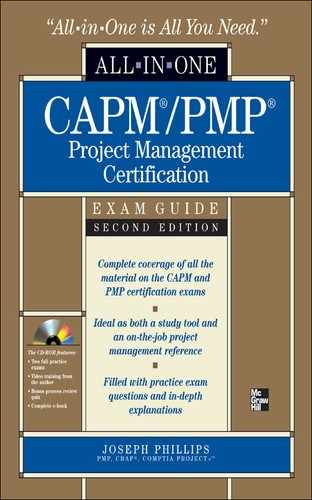Book Description
All-in-One Coverage of the CAPM and PMP Certification Exams
Get complete details on all the Certified Associate in Project Management (CAPM) and Project Management Professional (PMP) exam topics from this fully up-to-date volume. Written by industry expert, trainer, and project management consultant Joseph Phillips, this authoritative exam guide features learning objectives at the beginning of each chapter, exam tips, practice exam questions, and in-depth explanations. Designed to help you pass the exams, this definitive resource also serves as an essential on-the-job reference.
Covers all exam topics including how to:
• Implement project integration management
• Plan and control project scope
• Define, sequence, and manage project activities
• Estimate and administer the project budget
• Perform quality control
• Acquire and manage the project team
• Communicate project performance with stakeholders
• Monitor and control project risks
• Plan for procurement
• Adhere to the PMI Code of Ethics and Professional Conduct
The CD-ROM features
• Two full practice exams
• Video training from the author
• Bonus process review quiz
• Complete e-book
The ebook version does not provide access to the companion files.
Table of Contents
- Cover Page
- All-in-One CAPM®/PMP® Project Management Certification Exam Guide, Second Edition
- Copyright Page
- CD Page
- Dedication
- Contents
- Acknowledgments
- Introduction
- Part I Project Management Foundation
- Chapter 1 Preparing for the Exam
- Chapter 2 Managing a Project
- Chapter 3 Examining the Project Processes
- Part II Project Management Professional Testing Areas
- Chapter 4 Project Integration Management
- Chapter 5 Managing the Project Scope
- Chapter 6 Managing Project Time
- Defining the Project Activities
- Sequencing the Project Activities
- Estimating the Project Resources
- Estimating Activity Durations
- Developing the Project Schedule
- Applying Mathematical Analysis
- Calculating Float in a PND
- Encountering Scheduling on the CAPM or PMP Exam
- Applying Schedule Compression
- Using a Project Simulation
- Using Resource-Leveling Heuristics
- Using the Critical Chain Method
- Using Project Management Software
- Relying on a Project Coding Structure
- Considering the Outputs of Schedule Development
- Controlling the Project Schedule
- Chapter Summary
- Chapter 7 Managing Project Costs
- Chapter 8 Managing Project Quality
- Planning for Quality
- Performing Quality Assurance
- Performing Quality Control
- Preparing for Quality Control
- Inspecting Results
- Creating a Flowchart
- Creating a Control Chart
- Creating Pareto Diagrams
- Creating a Histogram
- Creating a Run Chart
- Creating a Scatter Diagram
- Completing a Statistical Sampling
- Revisiting Flowcharting
- Applying Trend Analysis
- Examining Quality Control Results
- Chapter Summary
- Chapter 9 Managing Project Human Resources
- Chapter 10 Managing Project Communications
- Chapter 11 Managing Project Risks
- Chapter 12 Introducing Project Procurement Management
- Chapter 13 Understanding the Code of Ethics and Professional Conduct
- Part III Appendixes
- Glossary
- Index
- MediaCenter Page
